Input interpretation

(4-benzylbenzyl)trimethylammonium chloride
Basic properties
(C)CC1=CC=C(C=C1)CC2=CC=CC=C2.[Cl-] InChI identifier | InChI=1/C17H22N.ClH/c1-18(2, 3)14-17-11-9-16(10-12-17)13-15-7-5-4-6-8-15;/h4-12H, 13-14H2, 1-3H3;1H/q+1;/p-1/fC17H22N.Cl/h;1h/qm;-1 InChI key | PLYPLIVCTAJWTK-UHFFFAOYSA-M](../image_source/d333b94b2153279d843ce8561361d476.png)
molar mass | 275.8 g/mol formula | C_17H_22ClN empirical formula | Cl_C_17N_H_22 SMILES identifier | C[N+](C)(C)CC1=CC=C(C=C1)CC2=CC=CC=C2.[Cl-] InChI identifier | InChI=1/C17H22N.ClH/c1-18(2, 3)14-17-11-9-16(10-12-17)13-15-7-5-4-6-8-15;/h4-12H, 13-14H2, 1-3H3;1H/q+1;/p-1/fC17H22N.Cl/h;1h/qm;-1 InChI key | PLYPLIVCTAJWTK-UHFFFAOYSA-M
Structure diagram
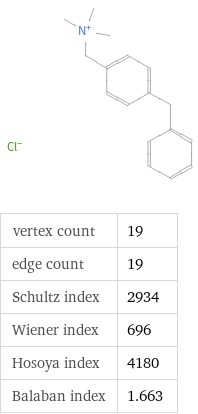
vertex count | 19 edge count | 19 Schultz index | 2934 Wiener index | 696 Hosoya index | 4180 Balaban index | 1.663
Quantitative molecular descriptors
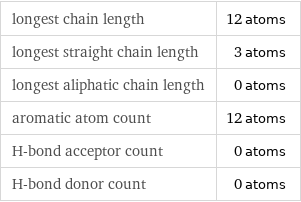
longest chain length | 12 atoms longest straight chain length | 3 atoms longest aliphatic chain length | 0 atoms aromatic atom count | 12 atoms H-bond acceptor count | 0 atoms H-bond donor count | 0 atoms
Elemental composition

Find the elemental composition for (4-benzylbenzyl)trimethylammonium chloride in terms of the atom and mass percents: atom percent = N_i/N_atoms × 100% mass percent = (N_im_i)/m × 100% Plan: • Write the chemical formula and gather atomic masses from the periodic table. • Determine values for N_i, m_i, N_atoms and m using these items. • Finally, compute the percents and check the results. Write the chemical formula: C_17H_22ClN Use the chemical formula to count the number of atoms, N_i, for each element and find the total number of atoms, N_atoms, per molecule: | number of atoms Cl (chlorine) | 1 C (carbon) | 17 N (nitrogen) | 1 H (hydrogen) | 22 N_atoms = 1 + 17 + 1 + 22 = 41 Divide each N_i by N_atoms to calculate atom fractions. Then use the property that atom fractions must sum to one to check the work: | number of atoms | atom fraction Cl (chlorine) | 1 | 1/41 C (carbon) | 17 | 17/41 N (nitrogen) | 1 | 1/41 H (hydrogen) | 22 | 22/41 Check: 1/41 + 17/41 + 1/41 + 22/41 = 1 Compute atom percents using the atom fractions: | number of atoms | atom percent Cl (chlorine) | 1 | 1/41 × 100% = 2.44% C (carbon) | 17 | 17/41 × 100% = 41.5% N (nitrogen) | 1 | 1/41 × 100% = 2.44% H (hydrogen) | 22 | 22/41 × 100% = 53.7% Look up the atomic mass, m_i, in unified atomic mass units, u, for each element in the periodic table: | number of atoms | atom percent | atomic mass/u Cl (chlorine) | 1 | 2.44% | 35.45 C (carbon) | 17 | 41.5% | 12.011 N (nitrogen) | 1 | 2.44% | 14.007 H (hydrogen) | 22 | 53.7% | 1.008 Multiply N_i by m_i to compute the mass for each element. Then sum those values to compute the molecular mass, m: | number of atoms | atom percent | atomic mass/u | mass/u Cl (chlorine) | 1 | 2.44% | 35.45 | 1 × 35.45 = 35.45 C (carbon) | 17 | 41.5% | 12.011 | 17 × 12.011 = 204.187 N (nitrogen) | 1 | 2.44% | 14.007 | 1 × 14.007 = 14.007 H (hydrogen) | 22 | 53.7% | 1.008 | 22 × 1.008 = 22.176 m = 35.45 u + 204.187 u + 14.007 u + 22.176 u = 275.820 u Divide the mass for each element by m to calculate mass fractions. Then use the property that mass fractions must sum to one to check the work: | number of atoms | atom percent | mass fraction Cl (chlorine) | 1 | 2.44% | 35.45/275.820 C (carbon) | 17 | 41.5% | 204.187/275.820 N (nitrogen) | 1 | 2.44% | 14.007/275.820 H (hydrogen) | 22 | 53.7% | 22.176/275.820 Check: 35.45/275.820 + 204.187/275.820 + 14.007/275.820 + 22.176/275.820 = 1 Compute mass percents using the mass fractions: Answer: | | | number of atoms | atom percent | mass percent Cl (chlorine) | 1 | 2.44% | 35.45/275.820 × 100% = 12.85% C (carbon) | 17 | 41.5% | 204.187/275.820 × 100% = 74.03% N (nitrogen) | 1 | 2.44% | 14.007/275.820 × 100% = 5.078% H (hydrogen) | 22 | 53.7% | 22.176/275.820 × 100% = 8.040%
Elemental oxidation states

The first step in finding the oxidation states (or oxidation numbers) in (4-benzylbenzyl)trimethylammonium chloride is to draw the structure diagram. Next set every oxidation number equal to the atom's formal charge: In (4-benzylbenzyl)trimethylammonium chloride hydrogen is not bonded to a metal with lower electronegativity, so it will have an oxidation state of +1. Any element bonded to hydrogen gains the bonding electrons, decreasing their oxidation state by 1 for every bond: With hydrogen out of the way, look at the remaining bonds. There are 4 carbon-nitrogen bonds, and 15 carbon-carbon bonds. For each of these bonds, assign the bonding electrons to the most electronegative element. First examine the carbon-nitrogen bonds: element | electronegativity (Pauling scale) | C | 2.55 | N | 3.04 | | | Since nitrogen is more electronegative than carbon, the electrons in these bonds will go to nitrogen. Decrease the oxidation number for nitrogen in every highlighted bond (by 1 for single bonds, 2 for double bonds, and 3 for triple bonds), and increase the oxidation number for carbon accordingly: Next look at the carbon-carbon bonds: element | electronegativity (Pauling scale) | C | 2.55 | C | 2.55 | | | Since these elements are the same the bonding electrons are shared equally, and there is no change to the oxidation states: Now summarize the results: Answer: | | oxidation state | element | count -3 | N (nitrogen) | 1 -2 | C (carbon) | 4 -1 | C (carbon) | 10 | Cl (chlorine) | 1 0 | C (carbon) | 3 +1 | H (hydrogen) | 22
Orbital hybridization
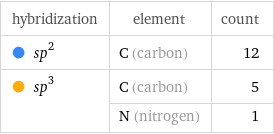
hybridization | element | count sp^2 | C (carbon) | 12 sp^3 | C (carbon) | 5 | N (nitrogen) | 1
Structure diagram
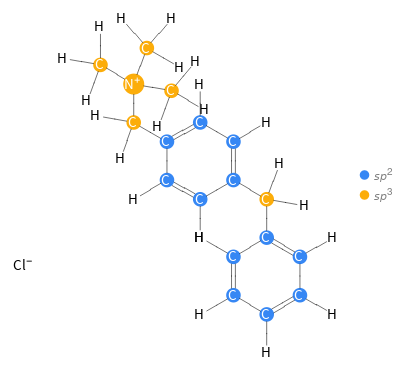
Orbital hybridization Structure diagram
Topological indices
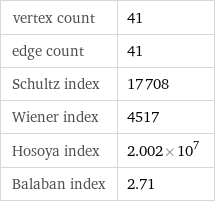
vertex count | 41 edge count | 41 Schultz index | 17708 Wiener index | 4517 Hosoya index | 2.002×10^7 Balaban index | 2.71